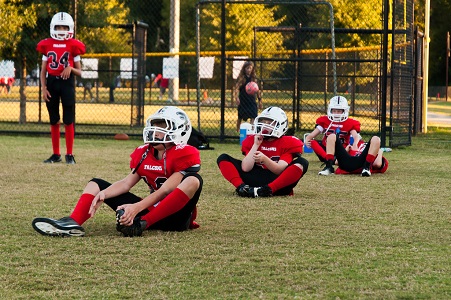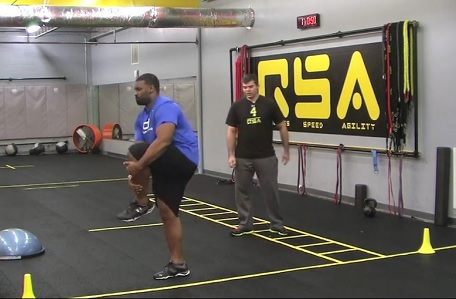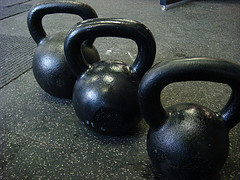Speed and Agility Training To Improve Sports Performance
by Todd Durkin
Speed kills. Speed and agility training in sport gives an athlete an edge on his/her competition. And the great news is that it can all be learned through technique training, proper drills, and hard work. If you’re wanting and willing to get faster, let’s dive (or sprint!) into the action.
In this article, you will learn all about improving your speed and agility training. You will learn about stride rate, stride length, and proper running mechanics. You will learn several different speed improvement training drills, exercises, and programs that will enable you to reach new levels in your sport.
And you will learn:
- Best strength exercises for speed development
- Top technique tips for speed performance
- Power and plyometrics to develop fast-twitch muscle fiber
- Nutrition for optimal fueling
- Top recovery strategies
So don’t be left in the dust. Dive into the article and find out all the in’s and out’s of improving your speed and agility.
SPEED TRAINING
First off, let’s understand speed training and its components. Here are the phases of Speed Training:
- Dynamic Warm-Up (see below; not really a phase of speed training but essential to include prior to speed training)
- Mechanics
- Acceleration (reaching maximum speed in the shortest amount of time possible)
- Top-End Speed
- Deceleration
- Change of Direction (Agility & Quickness)
As we talk about speed training, it is necessary to understand the following principles:
- “Stride Frequency”: The number of strides taken in a given amount of time or distance. This is improved via technique drills, cycling, towing, sprinting and bungee work.
- “Stride Length”: The distance covered from one stride when sprinting. Strength and flexibility are the most important factors to improve stride length.
All great speed and agility training programs should be preceded by a great General Warm-up and Dynamic Warm-up. A general warm-up is 5-10 minutes of exercise to begin elevating core tissue temperature, increase heart rate, and prepare the body for a workout or competition. Examples will include running, treadmill, jumping rope, elliptical, or bike.
One would then proceed into the Dynamic Warm-Up
Speed and Agility Training Dynamic Warm-Up:
Should be performed before every workout, practice or competition, and should take approximately 5-25 minutes.
The purpose of the Dynamic Warm-Up is to: Increase tissue temperature, improve flexibility, activate the nervous system, and help coordination and develop body awareness. It also lengthens fascia.
What is Fascia? Fascia is a specialized system of the body (connective tissue) which plays an important role in the support of our bodies. Fascia is a very dense connective tissue which envelops every muscle, bone, nerve, artery, and vein as well as our internal organs including the heart, lungs, brain and spinal cord. When fascia becomes constricted, it becomes tight, creates great pressure on its structures and becomes a great source of tension to the body.
The methods utilized to perform a dynamic warm-up are:
Movement in Space: (10-20 yards)
- High knees
- Butt-kicks
- Cariocas
- Exagerated Cariocas
- A-Skips
- B-Skips
- Frankenstein Walks (& skips)
- Lunge with rotation
- Reverse lunge with reach over top
- Side-lunges
Stationary:
- Jumping jacks
- Gate swings
- Pogo hops
- Seal jacks
- Arm circles
- Trunk rotations
- Cats & Dogs
- Downard Dog
- Scorpion Kicks
- 1 Legged Windshield wipers
- Bodyweight Squats
Perform each movement approx. 10-20 seconds.
Before a workout or competition, the emphasis is on a dynamic warm-up.
After a workout, the emphasis should be on static stretching and myofascial release.
Speed and Agility Training Flexibility:
Every time after you workout, practice or compete, there should be stretching that involves holding each stretch 20 seconds to 1 minute, and it should take 10 minutes minimally. Using a stretch rope, you should concentrate on your hip flexors, hamstrings, quads, calves, trunk and opening the chest and shoulders. The methods utilized to stretch are rope chest stretch, standing rotator cuff stretch, kneeling hip flexor stretch, cats & dogs, downward dog, lying rope hamstring stretch, lying rope lower back stretch, lying rope groin stretch, side-lying rope quad stretch, walking soldiers. Foam rolling (ie. The Grid or a foam roller) & a massage stick are essential to do on your own to promote fascia lengthening and recovery. This can be performed both before and after the workout.
When assessing speed, one of the most critical aspects is acceleration. Acceleration is defined as the ability and time it takes for the body to reach Top End Speed.
Mechanics and technique for acceleration include:
- Foot Contact behind hip
- Body angle at 45 degrees/Straight line from heel to neck
- Chin to chest
- Head down
Some of the best technique acceleration drills include:
- Marches along wall
- Wall Runs
- 3, 5, 7, 9 step wall sprints
STRENGTH, SPEED & ACCELERATION
A huge part of speed and agility training is acceleration, it is important to train and strengthen the posterior chain of the body—glutes, hamstrings, lower back, mid-back, and even the calves & feet. Some of the most effective methods and strength exercises to improve acceleration include:
- Sled Drags & Sled Pulls
- Resisted Towing
- Tire Flips
- Plate Pushes
- Keiser Air Runner
- Bullet Belt
- Super Band Leap Frogs
- Form running in place & move out
- Legged Romanian Deadlifts
- Calf Raises (Double & Single Leg)
- Swiss Ball Leg Curls
- TRX Hip Extensions/Bicycles, Leg Curls
- Hyperextensions (Glute/Ham)
- Barefoot Balance Touches (on airex pad)
- Planks
- Pullups
Once one achieves top-end speed (T.E.S.), the mechanics then change. Now, technique is a bit different:
- Foot Contact now under hip
- Body is upright
- Upper body relaxed
- Arms swinging 90-120 degrees from waist to chin; drive elbows back!
- T.E.S. typically reached at approximately 20-30 yards on a linear sprint
Some drills to reinforce Top End Speed Mechanics/Technique Drills include:
- Arm swing drills
- Fast Claw Drill
- Marches
- Skipping
Some of the best exercises and methods to improve acceleration and T.E.S. include:
- Uphill running
- Stadium Steps
- Resisted Speed Drills (bungees)
- Assisted Over-speed training with bungee
- High speed treadmill
Best Strength Exercises to Improve Overall Speed (& acceleration):
- Squats (2 legged & 1 legged)
- Step-ups
- Lunges (variations)
- Bulgarian Split Squats
- Deadlifts
- Plate Pushes
- Sled Drags
- Plyometrics (squat jumps, lunge hops, Box jumps, leap frogs, vertimax, etc.)
- Olympic Lifts (snatch, clean & jerk, clean, power shrugs) (power development)
- Core Conditioning (ie. hyperextensions, Glute/Ham Raise, Russian twists, Bosu Core, med ball standing twists, med ball standing windmills, med ball seated sidewinders, med ball side-tosses into wall, med ball throws (straight up), etc…
- Pullups
- Weighted arm swings
3 Tips for Speed Performance: (credit to Patrick Beith)
Tip 1 – Drive Phase – Don’t force yourself to “stay low”
The drive phase happens right after you react to the starting gun. Your initial 8 -10 steps is considered your drive phase. The biggest problem seen with athletes in the drive phase is that athletes are ‘trying’ to stay too low. Keep the body angle at about 45 degrees and keep the heel of the recovery leg low to the ground during the first 8 strides. Drive the foot into the ground and explode powerfully backwards to create maximum ground reaction force. Drive your elbows backwards and keep your head down. You should be in a straight line from your heels to your head.
Tip 2 – Acceleration Phase
In this phase, you want to think “powerful.” Since the acceleration phase (0-30 yards) is associated with a higher stride frequency then at maximum speed, focus on leg drive. You want to keep the feet behind your center of mass so that you can maximize leg drive. “Head down and drive.”
Tip 3 – Relaxation
One of the most challenging things to do is to stay relaxed while sprinting full speed. I often look at my athlete’s cheeks to see if they are running with “puppy dog” cheeks. If an athlete is too tense, their jaw will be tight and they will be tensing their entire body.
If you see an athlete with a tight face, eyes squinting, teeth clenched, elevated shoulders, and tight fists, they are actually slowing themselves down. You have to let your muscles work for you and not against to maximize your speed potential. This is a tough concept to learn and MUST be practiced if you want get the most out of our speed.
Relax and let your speed come to you!
There is an often forgot about third component to speed and agility training – and it is quickness. Let’s look at the difference.
Agility is the ability to accelerate, decelerate, and change directions as quickly as possible in the shortest amount of time possible
- Closely related to balance
- Should be able to move forward, backwards, left, & right all very well
Quickness is the ability to react to a stimulus in the environment in the shortest amount of time possible (a whistle, clap, defender, etc.)
- Closely related to reaction time
- Could be foot quickness or hand-eye quickness
Factors affecting Agility & Quickness:
- Ground Reaction Forces
- Reaction Time
- Acceleration & Deceleration
- Starting quickness (1st step quickness)
- Cutting
- Cross-over ability
Drills/Methodologies to Influence Agility & Quickness:
- Line Drills—runs back & forth, jumping jack feet, front hops, side hops, Ali shuffles, 1-legged lateral hops, 1-legged front hops
- 5 dot drill
- Mirror Drill
- Tag Drill
- Cone Drills (cone circles, box drill)
- Bag Drills (shuffles, figure 8’s, shuffle & figure 8’s)
- Agility Ladder drills (1 foot in each rung, sideways 2 feet in each rung, Ali shuffles, Icky Shuffles, NFL crossover drills)
- BOSU foot Quickness Drills
- Deceleration Drills
- Sprint & stop
- Sprint & stop and repeat
- Super Band overspeed/resisted speed drills (running forward & backward or left & right with Super Band; works acceleration & deceleration)
* Incorporate hand-eye coordination into any of these drills for additional quickness/reaction time.
To include hand-eye coordination and reaction time, you can include drills such as:
- Reaction ball drills (drops, rolls, into rebounder)
- Card Catch drills
- BOLA catches
Furthermore, if you are needing to increase your agility and quickness, you can use the same aforementioned exercises to improve your speed. Due to the fact that agility often is lateral quickness or involves cutting, it is imperative that the groins & hips are adequately worked also. The following exercises will augment the strength exercises found in the speed & acceleration section:
- Diagonal Lunges
- Slide Board
- Lateral Band Walks
- Side Lunges
- Dirty Dogs
- Horse-Back Riding
POWER for Speed and Agility Training
If an athlete really wants to reach full potential, they must be able to convert their strength into power. Power is defined as the ability of the neuro-muscular system to create a force rapidly. In its simplest term, power = strength + speed
- Strength– the maximal amount of force a muscle can generate under a given set of conditions
- Speed– the ability to move from one point to another point as fast as possible
Methodologies to improve power:
- Olympic lifting
- Plyometrics
- Strength training with speed component
For the sake of this discussion, I am going to concentrate on plyometrics to improve power (along with strength). Plyometrics is a system of hopping, skipping, jumping, or running that works on developing explosive power and maximally recruiting fast-twitch muscle fiber by eccentrically loading a muscle and quickly producing a concentric force. Plyometrics are exercises that enable a muscle to reach maximum strength in as short a time as possible. The faster the eccentric movement (the loading phase), the more stored elastic energy will be released, resulting in a more explosive jump.
Benefits of plyometrics:
- Improves power & elasticity
- Trains the nervous system
- Improves anaerobic conditioning
- Transformation of muscle strength into power
- Recruitment of most motor units and their corresponding muscle fibers
- Develops fast twitch muscle fiber!!!
Rules of plyometrics:
- Perform on soft surface
- Do early in your routine
- Land softly
- Have adequate strength base before introducing advanced levels of plyometrics (approx. 10 weeks of resistance training)
- No pain should be experienced in joints
- Be attentive to form & technique
- Be sure to stretch & work on strength & flexibility when using plyometrics as part of program
- Use a 1:3 work/rest ratio for most plyometric exercises
- Can be performed in many ways:
- immediately after dynamic warm-up
- Infuse it during your workout and perform immediately after a strength exercise (complex training)
- Can be performed on speed days also performed as separate sessions
3 Basic Categories of Lower Body Plyometric Exercises:
- Jumping—taking off on one or two feet; landing on 2 feet (jumping jacks, leap frogs)
- Hopping—taking off on one foot and landing on same foot (single leg hopping over line)
- Bounding—taking off on one foot and landing on other foot (alternate leg bounds)
3 Stages of Plyometric Program Design:
Off-Season (General Conditioning)—2 to 3 times per week; 80-100 foot contacts
Pre-Season (Sport Specific)—2 to 3 times per week; 100-150 foot contacts
In-Season (Sport Specific Maintenance)—1 to 2 times per week; 80-100 foot contacts
3 Levels of Plyometrics
Beginning
- Jumping Rope
- Jumping Jacks
- Line jumps & hops
- Squat jumps
- Tuck jumps
- Skater plyos
- Overhead Medicine Ball Tosses
- Med Ball Chest Passes
- Plyo Pushups on floor
- Medicine Ball rotational ab twists into wall
Moderate
- Box jumps
- Lateral box jumps
- 1 legged jumps (front & lateral)
- Supine medicine ball push presses (to partner)
- 1-legged lateral bounds
- Plyo situps
- Med ball throws into ground (with twist)
- Explosive pushups onto 2 steppers
- Explosive pushups onto 1 stepper
- Med ball push press to partner into plyo pushup & repeat
- Abdominal leg throws
- Med ball overhead tosses, sprint, and retrieve
Advanced
- Depth Jumps
- Depth Jump with multiple repeats
- Single leg triple jumps
- Smith Machine Bench Press Throws to partner
- Add another exercise to upper & lower body
- Keiser Air Runner or double leap frongs
- Increase height of box
- Incorporate single leg movements
- Use weighted vests
Recovery for Speed and Agility Training
With all this focus on proper training to improve overall athleticism, it is necessary to address one critical aspect to an athlete receiving maximum benefits from their training. It is called RECOVERY & REGENERATION. The following components play a critical role in determining how quickly an athlete can recover. The quicker the athlete can recover, the quicker they can train or perform again. Let’s take a look at a couple key components of recovery:
1) Nutrition is step one
- Protein is step one; we want to increase protein synthesis. One should consume approximately 1 g per lb. of body weight.
- A protein and carb drink promotes glycogen recovery faster than a carb drink alone following a workout. This helps stimulate protein synthesis.
- Good nutrition controls insulin, glucagon, leptin, and other very important hormones.
insulin—stores nutrients into cells
leptin—follows insulin & caloric intake/deposition
glucagon—releases fat
Nutrient Timing does play a role in overall nutrition
2) Flexibility (see beginning of article)
3) Foam Roller or Massage Stick (Self-Myofascial Release)
4) Bodywork (massage, Rolfing, Optimal Performance Bodywork, etc.)
5) Infrared Saunas
6) Supplementation
- Fish oils & Omega 3 Fatty Acids
- Glucosamine, Chondroitin, MSM
- Multi-vitamin & mineral Complex
- B12
7) Sleep
During sleep, the production of growth hormone, testosterone, and IGF-1 are at their peak. Growth hormone speeds the absorption of nutrients and amino acids into your cells and aids the healing of tissues throughout the body. Testosterone and IGF-1 are anabolic hormones that are important in muscle growth and assist in recovery also. It is recommended that you get at least 8 hours of sleep when trying to optimize hormone-release and recovery.
Now that you have the tools, it’s time to implement the game-plan and begin working towards improving performance and designing a great speed and agility program. If you combine training hard, the correct methodologies, along with ample recovery & regeneration techniques, it is then that you can maximize your strength, speed, and power development. GO GET IT!!!
What to learn how to teach speed mechanics like the pros?
Check out Ultimate Speed Mechanics

About the Author
Todd Durkin is an internationally-recognized strength and conditioning coach who works with numerous NFL, MLB, and NBA athletes. He is the owner of Fitness Quest 10 in San Diego, CA, and the author of The IMPACT! Body Plan. For more information, visit www.ToddDurkin.com or follow him on Twitter at @ToddDurkin.
 Dr. Greg Schaible is a physical therapist and strength coach specializing in athletic performance. Greg is the owner of On Track Physiotherapy and owner of the popular online education resource Sports Rehab Expert. Greg works with athletes and active individuals of all ages. As a former athlete himself, he attended The University of Findlay and competed in both Indoor and Outdoor Track & Field where he earned honors as a 5x Division II All-American and a 6x Division II Academic All-American.
Dr. Greg Schaible is a physical therapist and strength coach specializing in athletic performance. Greg is the owner of On Track Physiotherapy and owner of the popular online education resource Sports Rehab Expert. Greg works with athletes and active individuals of all ages. As a former athlete himself, he attended The University of Findlay and competed in both Indoor and Outdoor Track & Field where he earned honors as a 5x Division II All-American and a 6x Division II Academic All-American.













